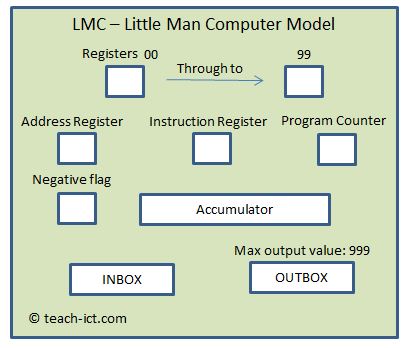2. LMC Computer
The LMC was designed to model a very basic Von Neumann computer.
Simulator
There are some free LMC simulators available (e.g. York University) which will load a LMC assembly language program then convert it into machine code and run it step by step.
They do vary from one another so some details will depend on which one your school is using. For example, some simulators allow negative numbers in the accumulator, some don't.
Decimal
Although a real computer uses binary numbers, for simplicity, the LMC instruction values are always in decimal.
The LMC simulates a basic CPU, using the following elements

INBOX: This holds an input value from the user.
OUTBOX: This represents an output value. Only three digits are allowed, so the maximum value is 999 decimal.
ACCUMULATOR: This holds a temporary value that is manipulated by operations such as add and subtract and so on.
REGISTERS: Values are stored in memory locations called registers, this includes the program itself (after all this is a von neumann machine). They are refered to by their location, ranging from location 00 up to location 99
NEGATIVE FLAG: This is set if the result of an operation in the accumulator is negative. (Some simulators only allow positive 000 -> 999 in the accumulator, but the negative flag is still set properly)
PROGRAM COUNTER: Holds the address of the next instruction. Lowest address 00, highest address 99
ADDRESS REGISTER: Holds the bottom two digits of the instruction just read from memory
INSTRUCTION REGISTER: Holds the top digit of the instruction just read from memory
The LMC assembly language is used to instruct this machine, step by step.
Challenge see if you can find out one extra fact on this topic that we haven't already told you
Click on this link: What is the LMC Little Man Computer
